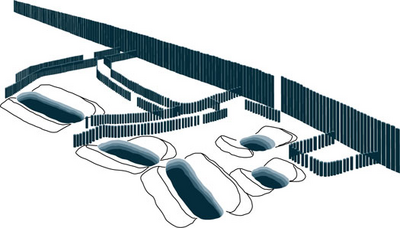The enclosed gathering places of the Neolithic period
At the same time as dolmens and passage graves were being built, large gathering places (sometimes called ‘causewayed camps’) were being laid out. These places could hold the whole population of a region. They were often at distinctive points in the terrain and were surrounded by palisades. Traces of rituals show that the places functioned first and foremost as cult sites. Around them lie oblong ditches in a special system. The ditches were emptied of soil and filled again many times. Perhaps the bodies of the dead were left there to decay, and the bones could later be placed in the dolmens and the passage graves? Gathering places were found in almost all the early farming societies in Europe.
At Sarup on Funen around 3400 BC a gathering place was established on a high-lying terrace between two water courses. It had an area of 500 m2. After a period the activities ceased and the site fell into disuse. In 3200 BC the place was re-established on a smaller scale. Afterwards it functioned as a settlement until c. 2800 BC.

